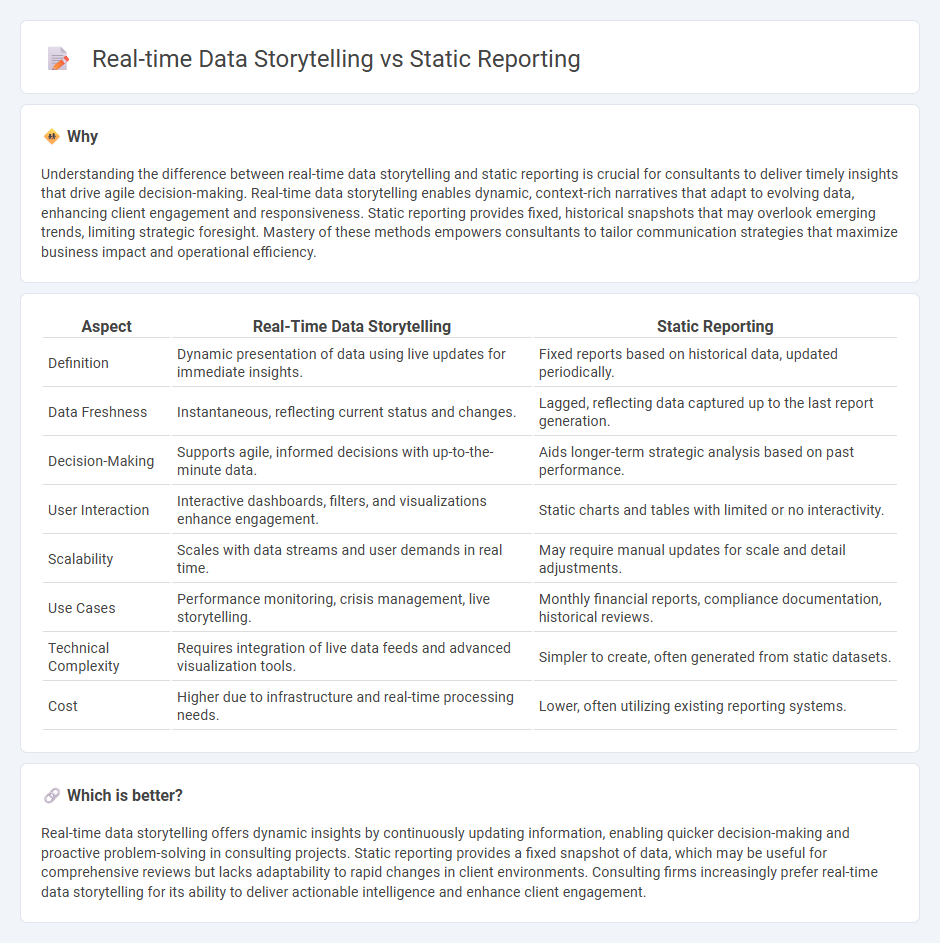
Real-time data storytelling transforms raw data into dynamic narratives that adapt instantly to unfolding events, enhancing decision-making with up-to-the-minute insights. Static reporting delivers fixed snapshots of data, often missing emerging trends and limiting proactive strategies. Discover how real-time data storytelling revolutionizes consulting outcomes by exploring its advantages over traditional static reports.
Why it is important
Understanding the difference between real-time data storytelling and static reporting is crucial for consultants to deliver timely insights that drive agile decision-making. Real-time data storytelling enables dynamic, context-rich narratives that adapt to evolving data, enhancing client engagement and responsiveness. Static reporting provides fixed, historical snapshots that may overlook emerging trends, limiting strategic foresight. Mastery of these methods empowers consultants to tailor communication strategies that maximize business impact and operational efficiency.
Comparison Table
| Aspect | Real-Time Data Storytelling | Static Reporting |
|---|---|---|
| Definition | Dynamic presentation of data using live updates for immediate insights. | Fixed reports based on historical data, updated periodically. |
| Data Freshness | Instantaneous, reflecting current status and changes. | Lagged, reflecting data captured up to the last report generation. |
| Decision-Making | Supports agile, informed decisions with up-to-the-minute data. | Aids longer-term strategic analysis based on past performance. |
| User Interaction | Interactive dashboards, filters, and visualizations enhance engagement. | Static charts and tables with limited or no interactivity. |
| Scalability | Scales with data streams and user demands in real time. | May require manual updates for scale and detail adjustments. |
| Use Cases | Performance monitoring, crisis management, live storytelling. | Monthly financial reports, compliance documentation, historical reviews. |
| Technical Complexity | Requires integration of live data feeds and advanced visualization tools. | Simpler to create, often generated from static datasets. |
| Cost | Higher due to infrastructure and real-time processing needs. | Lower, often utilizing existing reporting systems. |
Which is better?
Real-time data storytelling offers dynamic insights by continuously updating information, enabling quicker decision-making and proactive problem-solving in consulting projects. Static reporting provides a fixed snapshot of data, which may be useful for comprehensive reviews but lacks adaptability to rapid changes in client environments. Consulting firms increasingly prefer real-time data storytelling for its ability to deliver actionable intelligence and enhance client engagement.
Connection
Real-time data storytelling enhances consulting by transforming live data streams into dynamic narratives that guide strategic decision-making. Static reporting provides foundational insights through fixed datasets, enabling consultants to benchmark and validate trends highlighted in real-time analyses. Integrating both methods ensures comprehensive, actionable intelligence for clients seeking timely, evidence-based solutions.
Key Terms
Data Timeliness
Static reporting offers fixed data snapshots that often become outdated quickly, limiting timely insights in fast-paced environments. Real-time data storytelling delivers dynamic, up-to-the-minute updates enabling immediate decision-making and enhanced responsiveness. Explore how leveraging real-time data can transform your business analytics and drive proactive strategies.
Interactivity
Static reporting delivers fixed insights through predetermined charts and tables, offering limited user engagement and slow response to dynamic data changes. Real-time data storytelling enhances interactivity by enabling users to explore live data streams with interactive dashboards, filters, and visualizations that adapt instantly to user inputs. Explore the benefits of integrating real-time interactivity into your data narrative for more impactful decision-making.
Decision Support
Static reporting provides historical data snapshots ideal for trend analysis and compliance but lacks immediacy and interactivity crucial for dynamic decision-making. Real-time data storytelling integrates live data streams with narrative visualization, enhancing situational awareness and enabling proactive responses in fast-paced environments. Explore how real-time data storytelling transforms decision support systems by optimizing insight delivery and stakeholder engagement.
Source and External Links
Dynamic vs Static Reports: Examples + Free Templates - Coefficient - Static reports provide a fixed snapshot of data at a specific point in time and do not update automatically unless manually refreshed.
Dynamic Reports vs. Static Reports - What Is Better? - Whatagraph - Static reports are easy to share and useful for historical analysis, offering consistent information about performance during a defined period but do not allow for deeper, real-time investigation.
Static Vs. Ad-Hoc Reporting | Grow.com - Static reporting is best for routine, standardized information needs, delivering pre-defined metrics at regular intervals to support consistent decision-making.
 dowidth.com
dowidth.com